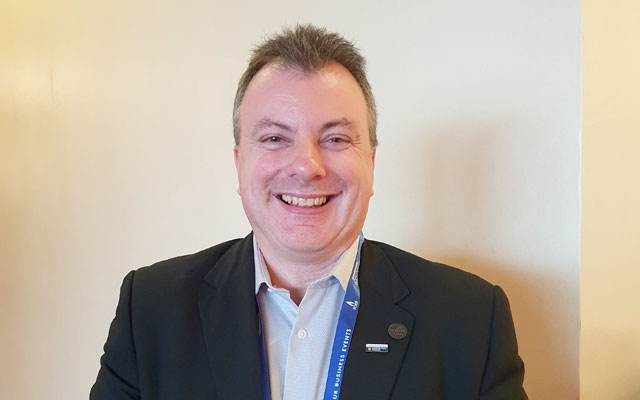Iain Bitran, executive director of the International Society for Professional Innovation Management, talks about knowledge legacies and the importance of working with a reliable, relevant convention bureau
The International Society for Professional Innovation Management (ISPIM) has confirmed its first meeting in Japan. How did this decision come along?
I’ve never heard of Fukuoka before my meeting with Fukuoka Convention and Visitors Bureau (FCVB) at IT&CMA 2015. It turned out to be the best prepared convention bureau I’ve ever met.
They came to our meeting with all the materials and information that I’ve always wanted. They provided a report on business innovation in Fukuoka, a list of industries in the city, names of all the universities in the city, etc. They even had a person from Fukuoka at the booth who could answer my questions about the city.
I was so impressed at the end of the meeting (that) I told myself that I’ve got to do an innovation event in Fukuoka.

So did you decide right away that Fukuoka’s the one for the next ISPIM meeting?
Well, no. The next step for me (after the meeting at IT&CMA 2015) was to plan a trip to Fukuoka to get prepatory work done, with a view of doing an event in 2019 or 2020.
However, things accelerated when FCVB informed me that ICCA will be doing something in the city in June (ICCA Associations Meetings Programme, June 29 to July 1, 2017). I have been doing a lot of stuff with ICCA recently and my involvement would take me to Fukuoka. So I arrived a few days earlier for a site inspection, and realised that 2018 was free on their calendar. I decided then to do Fukuoka in 2018 instead of waiting till 2019 or 2020.
But before the trip to Fukuoka I caught up with my friend Roy (Palmer, executive director) of the Association of International Seafood Professionals (AISP). I told him about my meeting with FCVB. Roy had done events in the past in Japan, in Kagoshima in 2013 which went very well. So he proposed that we co-locate our events in Fukuoka, where his association will run a track on innovation in the seafood industry at my summit (in addition to AISP’s own programme) and both associations will co-host social events. It was the perfect arrangement.
So Roy and I went on the site inspection of Fukuoka together in June, and extended two days in Hiroshima. We hope to do a one-day post trip to Hiroshima, a city most people have heard so much of. Japan has an amazing power of recovery and ability to create success out of disasters. Not just Hiroshima (Atomic bombing, 1945) but also cities like Kobe (Great Hanshin earthquake, 1995) and Sendai (Tohoku earthquake, 2011). There’s so much our innovation colleagues can learn from Hiroshima.
My hope is that following our 2018 event in Fukuoka, we could return to other parts of Japan for yet another event, say in Hiroshima or Kobe or somewhere else.
What were your first encounters with other convention bureaux like?
Some convention bureaux will give you only maps, others will give you money (for hosting your meeting there) but that’s just the sum of their involvement.
But what does an association want from a convention bureau? For ISPIM, we see the convention bureau as the first port of call whenever we consider taking an event to a city. The convention bureau has to become our partner and provide us with local connections.
We know every city has hotels and venues, but what we don’t know is the local innovation community, the relevant government agencies, the presence of innovation incubators in the city and state of the local start-up scene. We need the convention bureau to make these local connections for us. If they can’t, why should we take our event to the city?
So you don’t care much for financial subsidies?
It helps to some extent, of course. Our events must be affordable for everyone because we attract academics and non-academics. To get a programme going, we need sponsorship which is more and more difficult to find these days, so some local subvention always help. Money we save in some areas can be used elsewhere to offer a better programme.
But between the two – great local connections and generous subventions from a convention bureau, I’d rather have local connections. That is far more important to us. Somehow, we will always find ways to make things happen, even without any financial support.
I’ve been so impressed with the materials FCVB had prepared for me, that I’ve been showing them to other convention bureaux, telling them that this is best practice. Those materials have also enabled me to think broader and discover ways to work with another industry association to enhance content. It was through them that I learnt that there are five main industry sectors in Fukuoka, one of which is seafood – and that sparked collaboration possibilities with AISP.
FCVB understands what needs to be done to attract an association event. Not only did the representatives come to our meeting with the right materials, they had also proactively gone out to meet some of ISPIM members in Japan to understand what our event is like and what issues are important to us.
Do you think that there are enough convention bureaux that are doing it right?
No. Many talk endless about their city’s infrastructure and ask how big my event is, do I use a convention centre and do I use a DMC or PCO. They then pass me a list of all that. That’s not what I want. For ISPIM, the connection with the local innovation community is critical. Without that, we are just tourists in a destination and nothing more will happen after the meeting ends.
A lot of associations are talking about legacy these days; what do you leave behind after attending a conference in a destination. I don’t think convention bureaux look at this particularly well.
There are some exceptions, of course. Auckland is very good at looking at event legacy, which is understandable because the convention bureau sits right under the national economic development agency.
The fact that we could say we’ve been to a city and left something (knowledge) behind, will enable us to consider the city again for future events. Because if we don’t (establish a legacy), there is no measurement of our achievement, and we will just move on to somewhere else, another city that will want to help us make the right connections and bring benefit to the local economy and community.
In many cases, convention bureaux are just concerned about bringing that one event in.
Do you think the rotational nature of association meetings encourage such one-off relationships with the convention bureaux?
Maybe. But associations speak to one another and we become ambassadors of certain destinations.
Let’s talk more about local connection. Why is this critical?
For ISPIM, a successful event needs to have 25 per cent local delegates and 75 per cent international. We can showcase innovation in the host city, look at the various industry clusters and discuss the challenges the local community faces.
Nobody wants to hear only how good things are. That isn’t beneficial. They want to understand challenges and share possible solutions. A question may be asked and somebody from a different part of the world, from a different industry, may have an answer to that or suggest a different way of approaching the problem. We want people to share knowledge and are always thinking of ways to engage our people. Our conferences have evolved in this manner.
But to achieve this high level of engagement, we need to know how to interest the local community.
What could poor local connections do to your events?
In 2016, our summit in Kuala Lumpur drew around 140 people. We usually aim for 200 people at least. It was a relationship issue with this event. The CEO of the Malaysia Foundation for Innovation left his position when we started promoting Kuala Lumpur at our event in Brisbane a year before.
Originally we talked about doing something together with the Foundation, but after the CEO’s departure we were told that the collaboration was off. The foundation was going to bring in 50 delegates, which would have placed our attendance at 190, closer to our 200 target. To make things worse, the foundation put up a free innovation event a day after ours. A lot of the government delegates went to that event instead.
Additionally, many speakers from the local companies only showed up for their presentation slot at our conference and did not bring their people with them. The local involvement was very weak – barely 25 per cent of our total delegate numbers, which is our usual target.
Here’s another lesson – when we did our 2014 event in Singapore, we worked with a professor in the Singapore Management University. I got a little lazy and relied only on his network, which meant that our attendance in 2014 was smaller than the one we had in 2008.
Since then, we have decided to postpone our 2017 Singapore event to 2019 and use these couple of years to know people in agencies like A*STAR (Agency for Science, Technology and Research), SPRING Singapore (a government agency supporting local enterprises), National Research Foundation, National University of Singapore, etc. I want them to be enthusiastic about our event, and to want to participate in it with quality speakers and content. Without them, I’m relying on one person’s network again.
So what’s did you learn?
We learnt that we must have more than one local partner. That is why I told FCVB that they may have done an excellent job impressing us, but the real work starts now. I’ve asked them to host a half-day event where people from the local innovation community will be invited to talk about content, speakers, venues, promotions and delegate incentives, everything. The event has to benefit everyone – ISPIM and the local stakeholders. I want to know what is it they want out of the conference so I can build it into the programme sooner.
It is also important to ask the right questions to the convention bureau. Singapore Tourism Board (STB) is helping me with delegate boosting now. It didn’t in 2014 because I didn’t know to ask them.
Would you agree that an association’s relationship with the convention bureau could be a better one if associations came prepared too?
Well, yes. The association must know what it wants and engage the convention bureau in the right manner for a successful relationship. If we were able to say exactly what we wanted, then we would hope the convention bureau could find the right people to help achieve what we need to do.
What I used to do at tradeshows, was to have a draft RFP (Request For Proposal) showing what I needed. I realised that made us talk mostly about (the city’s hotels, venues and attractions) and not about other critical driving factors that I’ve mentioned earlier.
So in the past year we have changed our approach to enable us to better articulate what we need from the city to host an event there.
ISPIM has events around the world. How is it different building delegate numbers in the different regions?
ISPIM Conference had 120 delegates in Athens 2006, over 400 in Vienna 2009, and over 500 in Barcelona 2012. After that we capped our European conferences at 500 pax. Europe is a lot more compact, making it easier for us to form communities.
In 2008 we started our first non-European event in Singapore (ISPIM Innovation Symposium), with 180 delegates or so. We moved it around the world, but there was no real connection. One year it was in Canada, the next in New Zealand, and they are not quite neighbours.
After the sixth ISPIM Innovation Symposium in Melbourne, 2013, where we got 201 delegates, we decided to kill it and split our conferences by regions – Europe, North America and Asia-Pacific.
We have been building up momentum in North America and the delegate numbers are growing.
But it is more problematic in Asia-Pacific, which is a large geographical region. The countries and culture are so unique that it is more challenging to create communities.
We thought of having a conference for just the South-east Asia region, but eventually ditched that to focus only on big innovation cities in Asia-Pacific like South Korea, Japan, Taiwan, Singapore, New Zealand and Australia.
You’ll notice that I’ve left out China because at this moment it is just too much hard word to for us to grow there (laughs).
An event destination has to be easy for people to go to, without having to struggle with visa, and easy for associations to hold an event, without having to struggle with getting the right licences. The barriers to entry are high in China, and some ways in India too.
So you have two biggest populations, two biggest markets in the world that are not quite accessible to us right now. But we will get there eventually (laughs).
An innovator at heart
Iain Bitran is the executive director of ISPIM, the International Society for Professional Innovation Management. It is an association of members from research, industry, consulting and the public sector, all sharing a passion for innovation management – how to successfully create new products, processes and services from ideas to stimulate economic growth and well-being.

Formed in Norway in 1983, ISPIM has members in over 70 countries and is the oldest, largest and most active innovation network in Europe, expanding rapidly in the Americas and Asia-Pacific.
As well, since 1993, Bitran has been the co-founder and chief technology officer of Enterprizer Technologies, the provider of intelligent decision management solutions driven by Enterprizer, an innovative enterprise modelling system. He worked on many client projects with enterprises, governments and NGOs. As lead designer of Enterprizer, Bitran trained consultants to use Enterprizer and was been involved in many EU and UN funded projects. In 2017 Enterprizer Technologies split into two main business areas, Enterprizer Consulting and Enterprizer Events, with Iain becoming CEO of the latter.
This article was first published in TTGassociations January 2018











